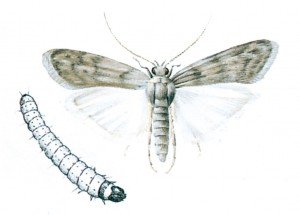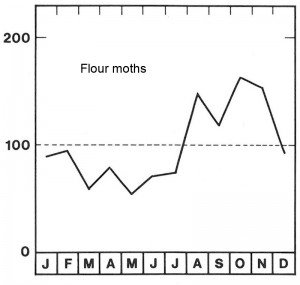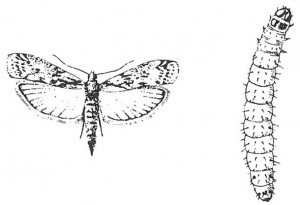

Latin: Anagasta kuehniella or Ephestia kuehniella.
The rather narrow wings have a span of 20-25 mm. Forewings are leaden with dark, zig-zag-shaped transverse lines and dots. The rear wings are pale gray with long fringes on the back edge. The Mediterranean flour moth larvae which can be 15-19 mm long, are white, pink or bright green.
The Mediterranean flour moth probably comes from the Middle East. In 1877 it was found for the first time in Europe in a consignment of wheat from North America and it has since spread across the world. In many countries, the Mediterranean flour moth is in virtually all establishments where flour and other grain products are manufactured or stored.
The larvae prefer wheat flour, but do not reject other flour and grain products. When wheat flour is not available, also grains, seeds, dried fruit, almonds, nuts and macaroni are eaten by flour moth larvae.

The damage is not limited to that which the larvae directly eat. Flour with moth larvae is stained gray-brown by the excrement and will get an unpleasant smell and lumps. In mills where the Mediterranean flour moths are found in large numbers, hoppers and strainers of fibre clog, so you constantly have to stop and clean it out. To avoid this, as well as complaints from customers, some mills are regularly gassed against flour moths. The adult moths do not take nourishment. In daytime they sit quietly, preferably in dark places. After mating, which can last for up to 15 hours, the female lays about 200 eggs within a few weeks. At 20 ° C the eggs hatch in 11 days but at 30 ° C it only takes 3 days until the tiny, 1 – 1.5 mm long, flour moth larvae come out of the eggs. At 17 ° C the larval stages altogether last four months and the pupal phase lasts 16 days. At 30 ° C development speed is increased. Larval development lasts a month and the pupal stage one week. In unheated rooms the larvae hibernate in the winter. In places that are heated in winter, at least four generations can develop per year, and you will find moths and larvae of all ages.




